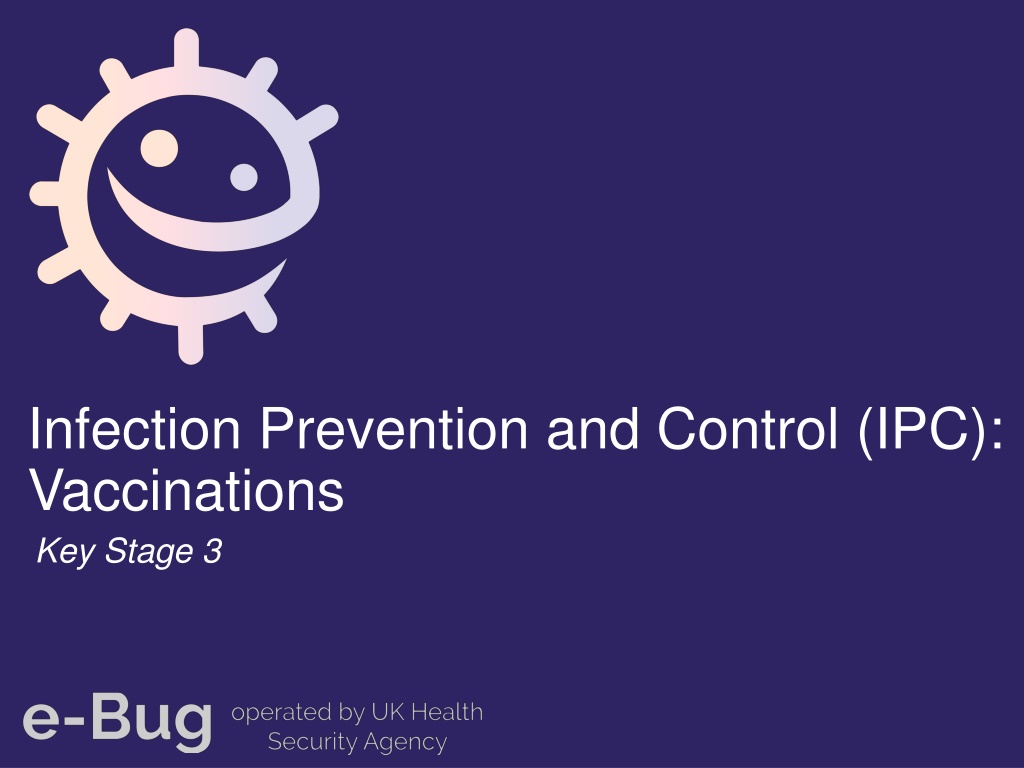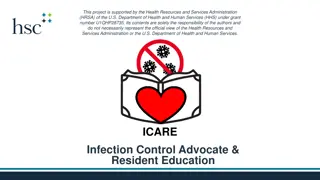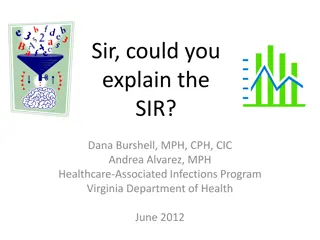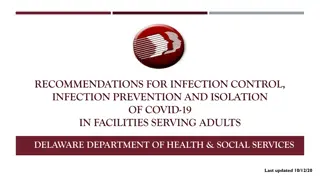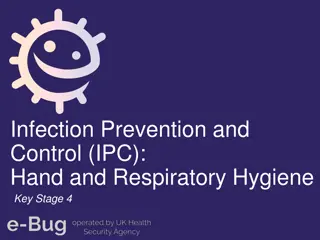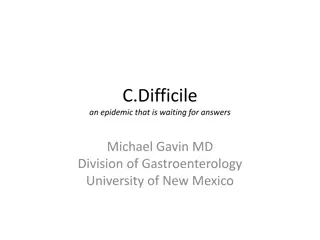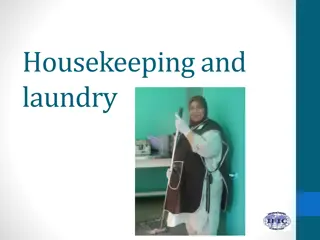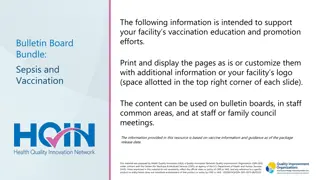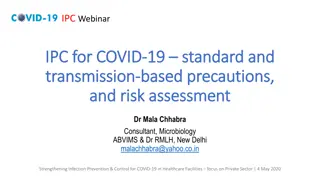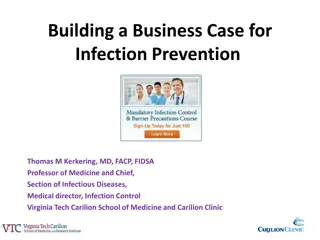Importance of Vaccinations in Infection Prevention and Control
Understanding the significance of vaccinations in preventing bacterial and viral infections is crucial. Vaccines help the body develop immunity against harmful pathogens, contributing to overall public health through concepts like herd immunity. Learning about the body's natural defenses and the role of vaccines in disease prevention is essential for students to grasp the importance of vaccination.
Download Presentation

Please find below an Image/Link to download the presentation.
The content on the website is provided AS IS for your information and personal use only. It may not be sold, licensed, or shared on other websites without obtaining consent from the author. Download presentation by click this link. If you encounter any issues during the download, it is possible that the publisher has removed the file from their server.
E N D
Presentation Transcript
Infection Prevention and Control (IPC): Vaccinations Key Stage 3
Learning Outcomes All students will: Understand that the human body has many natural defences to fight infection, including the 3 main lines of defence. Understand that both vaccines and becoming infected and developing natural immunity help prevent a range of bacterial and viral infections. Understand that the most common infections such as the common cold or sore throat are not prevented by vaccines. e-Bug.eu
Curriculum Links PHSE/RHSE Health and prevention Science Working scientifically Cells and organisation Experimental skills and investigations Analysis and evaluation English Reading Writing Geography Human and physical geography Geographical skills and fieldwork e-Bug.eu
Why it is Important to get Vaccinated? Immune means that you are protected from the serious effects of infection and that immunisation is a way of increasing the body s protective immunity to both bacterial and viral diseases. Vaccines are a small, inactive and harmless amount of the microbe/disease which teaches our body how to fight the harmful microbe when or if we get attacked by the disease. e-Bug.eu
Why it is Important to get Vaccinated? Antibodies pass from mother to child through the placenta in the womb and breast milk after birth helping to protect new- born babies from disease. However, this doesn t work for all diseases, e.g. women are given a vaccine when they are pregnant to protect their unborn baby from whooping cough. This will provide protection from when the baby is born until they are old enough to have their own vaccine (8 weeks old). Each type of microbe has an outer coating which is unique to the microbe, but because some microbes change their outer coats so quickly, it is difficult for scientists to make vaccines for these infections, or, like the flu vaccine, a new one has to be made each year. e-Bug.eu
Main Activity: Herd Immunity Class Stimulation e-Bug.eu
1. Make sure everyone has a red, white, blue, and yellow card 3. A person in the middle of the room raises their hand with the red card 6. Continue the game by holding blue recovering cards to mark day 2 2. 25% of the class will have the yellow vaccinated card and 75% the purple susceptible card don t let anyone see what card you have 4. The people next to the red card are now infected , and so on 7. Now, repeat the game with 50% and 75% vaccinated. What do you notice? 5. Only vaccinated people are not infected e-Bug.eu
Discussion e-Bug.eu
Discussion Points Why is vaccination not only a personal health issue but also a public health issue? What needs to be done to completely eliminate an infectious disease? Why hasn t the flu vaccine eliminated the influenza virus? e-Bug.eu
Extension Activities e-Bug.eu
Coloured Cards Recovering but still infectious Infected Immune Susceptible Vaccinated e-Bug.eu
Herd Immunity Scenario Use this sheet to record your observations after each stage of the scenario. Then add your conclusions. Number of Students Vaccinated Day 25% 50% 75% 1 2 3 4 5 6 7 e-Bug.eu
Herd Immunity Scenario As more people get vaccinated, what happens to the spread of the infection? ______________________________________ ______________________________________ ______________________________________ ______________________________________ ______________________________________ ______________________________________ Draw a graph to illustrate the results. e-Bug.eu
Herd Immunity Scenario Conclusions 1. What is herd immunity? __________________________________________ __________________________________________ 2. What happens when vaccination drops to a low level within the community? __________________________________________ 3. Why is a vaccine regarded as a preventative measure and not a treatment? __________________________________________ __________________________________________ e-Bug.eu
Herd Immunity Scenario - Answers Use this sheet to record your observations after each stage of the scenario. Then add your conclusions. Number of Students Vaccinated Day 25% 50% 75% The results in this table will vary depending on the number of people in the class and where the vaccinated people are positioned in relation to the susceptible people. There will however be a decreasing trend of infected people as more people get vaccinated. 1 2 3 4 5 6 7 e-Bug.eu
Herd Immunity Scenario - Answers As more people get vaccinated, what happens to the spread of the infection? ______________________________________ ______________________________________ ______________________________________ ______________________________________ ______________________________________ ______________________________________ ______________________________________ spread. Vaccination programmes make it extremely difficult for diseases to spread in a community. As more people get vaccinated or become infected and develop natural immunity they become immune to the disease therefore the disease cannot Your graph Draw a graph to illustrate the results. e-Bug.eu
Herd Immunity Scenario - Answers Conclusions 1. What is herd immunity? __________________________________________ __________________________________________ becoming infected and developing natural immunity, provides protection to unprotected individuals. Herd immunity (or community immunity) describes a type of immunity that occurs when vaccination of a portion of the population or 2. What happens when vaccination drops to a low level within the community? __________________________________________ When the vaccination drops to a low level, people start contracting the disease again leading to a re-emergence of the disease. 3. Why is a vaccine regarded as a preventative measure and not a treatment? __________________________________________ __________________________________________ from causing serious infection. Vaccines are used to boost the body s immunity so that when a microbe does enter the body, the immune system is ready to fight it preventing the microbe e-Bug.eu
Study the world map and record the vaccines that are required for specific countries in each region. Also name the disease that the vaccine provides protection for and the microbe that causes the disease. If needed use government, NHS, World Health Organisation and UK Health Security Agency websites to help you to investigate current vaccine information. World Map e-Bug.eu
Western Europe Russia Canada Far East Asia S. America Africa Australia Answers e-Bug.eu
Western Europe Russia Canada Canada: MMR; DTaP (Diphtheria, Tetanus and Polio); Typhoid; Hep. A; Hep. B; Rabies Far East Asia S. America Africa Australia Next e-Bug.eu
Western Europe Russia Canada South America: Far East MMR; DTaP; Typhoid; Hep. A; Hep. B; Rabies; Yellow Fever; Malaria Asia S. America Africa Australia Next e-Bug.eu
Western Europe Russia Canada Western Europe: MMR; DTaP; Typhoid; Hep. A; Hep. B; Rabies; Far East Asia S. America Africa Australia Next e-Bug.eu
Western Europe Russia Canada Africa: MMR; DTaP; Typhoid; Hep. A; Hep. B; Rabies; Yellow Fever; Encephalitis; Cholera; Meningitis; Far East Asia S. America Africa Australia Next e-Bug.eu
Western Europe Russia Canada Russia: DTaP; Typhoid; Hep. A; Hep. B; Rabies; Encephalitis; Far East Asia S. America Africa Australia Next e-Bug.eu
Western Europe Russia Canada Far East: MMR; DTaP; Typhoid; Hep. A; Hep. B; Rabies; Encephalitis; Far East Asia S. America Africa Australia Next e-Bug.eu
Western Europe Russia Canada Asia: MMR; DTaP; Typhoid; Hep. A; Hep. B; Rabies; Encephalitis; Cholera; Far East Asia S. America Africa Australia Next e-Bug.eu
Western Europe Russia Canada Australia: MMR; DTaP; Typhoid; Hep. A; Hep. B; Rabies; Encephalitis; Far East Asia S. America Africa Australia e-Bug.eu
Russia Western Europe Canada MMR; DTaP (Diphtheria, Tetanus and Polio); Typhoid; Hep. A; Hep. B; Rabies. DTaP; Typhoid; Hep. A; Hep. B; Rabies; Encephalitis MMR; DTaP; Typhoid; Hep. A; Hep. B; Rabies Far East MMR; DTaP; Typhoid; Hep. A; Hep. B; Rabies; Encephalitis Asia S. America MMR; DTaP; Typhoid; Hep. A; Hep. B; Rabies; Encephalitis; Cholera MMR; DTaP; Typhoid; Hep. A; Hep. B; Rabies; Yellow Fever; Malaria. Africa Australia MMR; DTap; Typhoid; Hep. A; Hep. B; Rabies; Encephalitis MMR; DTaP; Typhoid; Hep. A; Hep. B; Rabies; Yellow Fever; Encephalitis; Cholera; Meningitis. e-Bug.eu
Learning Consolidation e-Bug.eu
Write a Paragraph or Three Statements to Summarise What You Have Learned During the Lesson. e-Bug.eu
